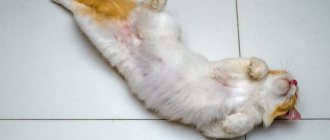If a cat asks for a cat after sterilization, you should pay attention to this. Prolonged meowing requires contacting a veterinarian, because in the process of tubal ligation, side effects in the form of inflammatory processes are possible. And also in the case when a pet is operated on in unverified clinics, the likelihood of an unprofessional operation increases.
What is cat sterilization? Types of surgery
Tired of cat concerts, puddles in the wrong places, sleepless nights, the cat owner makes a difficult decision - to give his pet under the surgeon’s knife. Doctors offer several options for the operation. Of these, oophorectomy and ovariohysterectomy are popular.
An oophorectomy is an operation in which only a cat's ovaries are removed. In an ovariohysterectomy, the ovaries and uterus are removed. After surgery, the animal loses its ability to reproduce, hormonal changes occur in the body, and the cat ceases to feel the need to find a partner. Thus, the heats stop, and with them the screams, marks, and attempts to escape from the house.
However, some cat owners complain that even after surgery their pet exhibits sexual behavior. The cat raises its tail again, caresses itself, and leaves puddles in the wrong places.
Let's figure out why a cat asks for a cat after sterilization and what the owner should do with his pet in this case.
Why does the female raise her butt and demand a cat?
Poorly performed surgery
In this situation, the solution to the problem will be to repeat the operation on the animal.
The cause of an incorrectly performed operation cannot be ruled out. The remaining ovarian tissue can regenerate and grow back. This process is called ovarioreminant syndrome - an uncommon occurrence that occurs due to the unprofessionalism of the veterinarian. In these cases, the cat meows after sterilization and can accept the cat. She requires a repeat ectomy of the formed ovaries and remaining tissue.
Physiology: hormonal changes
It is possible that the cat raises the back of its body and walks due to the functioning of the hormonal system even before the intervention. Sometimes the female screams again if castration is carried out at the age of over 1 year, especially when lambing has already occurred. In such a situation, the cat may want a cat for up to 12 months. There may also be an excess of hormones produced by the pituitary gland, adrenal glands or hypothalamus.
Psychological reasons
A successfully carried out procedure leads to a solution to the problem of missed trays.
Thanks to the ectomy of the reproductive organs, the female does not suffer from constant hormonal changes, does not want a cat and stops screaming. The pet becomes calmer. After castration, cats are less aggressive and conflict-free, and regularly go to the litter box. The instinct to procreate after removal of the reproductive organs is absent, which means the female does not require a male. If a kitten is neutered before her first heat, she will not meow.
Hormones are raging
After removal of the ovaries, the role of producing sex hormones can be taken over by the adrenal glands. This way the cat will continue to walk. Some tumors also produce sex hormones.
According to the latest research results, every 7th cat after sterilization regains signs of sexual heat. A high content of sex hormones is found in the blood of such cats. Veterinarians call this condition “reminent ovarian syndrome.”
Sterilization or castration: which is better to choose?
An ectomy is a serious process, but it has many benefits. Thanks to the procedure of removing the reproductive organs, the female has no surges in hormones. The cat becomes calmer after surgery. The process has a beneficial effect on the health and condition of the pets; they do not want to go for walks. Extomy of the reproductive organs eliminates the likelihood of the formation of inflammatory processes in the ovaries and uterus, which are dangerous for the animal and can be fatal.
Veterinarians consider sterilization a pointless operation, because the organs continue to produce hormones. The cat is still equally bothered by hormonal surges, which manifest themselves as follows:
After this procedure, the animal will still periodically meow and look for a partner.
- The animal walks and continues to meow.
- The pet is lethargic and apathetic, refuses to eat.
The female can ignore the tray during estrus and is capable of marking her territory. Moreover, the ovaries and uterus can become inflamed when females are walking, without gestation, which should end estrus. This can even lead to the formation of cancer in the reproductive organs. Therefore, professionals recommend castrating the animal to avoid side effects, additional stress, the likelihood of inflammatory processes and even oncology.
Wait
If immediately after castration the cat’s behavior has not changed for the better, then it is assumed that sex hormones produced before the removal of the ovaries remain in the body. They circulate in the cat's blood for about a month. After this time, the pet should calm down.
If this does not happen, then most likely mistakes were made during the operation or there is ectopic ovarian tissue in the cat’s body. In this case, the doctor will suggest performing a second operation, finding and removing ovarian tissue, or giving medications to regulate sexual desire.
What to do?
If a cat meows for a long time and asks for a cat, then the right option would be to consult a doctor; you should not take independent steps to alleviate the pet’s condition.
If your animal continues to exhibit this behavior, you should consult a doctor.
Only a veterinarian, after examining the animal, will be able to make a preliminary diagnosis, and relying on test results to confirm it. After the disease has been diagnosed, it is possible to prescribe the optimal treatment process, which will be suitable on an individual basis. The use of sedative hormones is contraindicated. This may contribute to the formation of cancerous tumors. Often, your veterinarian will suggest using safe herbal sedatives. It is also important after surgery to gradually reduce the amount of food or switch to a less caloric one. This is done for the following reasons:
- After removal of the reproductive organs, the animal is prone to weight gain.
- Excess energy interferes with calm.
If overexcited, the veterinarian suggests placing the cat separately. A minimal amount of stress will speed up the onset of peace and help avoid drug therapy. Often, in the postoperative period, the female recovers quickly. On day 2 the animal is already active. If the cat starts screaming after the intervention, the veterinarian prescribes Depogeston or Covinavet, Gestrenol or Libidomin.
A humane alternative to surgery: we use hormonal contraceptives for your pet
To avoid castration (sterilization) surgery, which may not bring the desired result, experienced cat owners choose the drug SEX BARRIER to regulate their pet's sexual desire.
SEX BARRIER is a bihormonal contraceptive drug that takes into account the type and sex of the animal. Use SEX BARRIER and forget about the fear of putting your beloved cat under the surgeon’s knife. SEX BARRIER copes with all the problems associated with a pet's estrus humanely, safely and effectively.
At what age is sterilization performed?
If we talk about sterilization, then you need to know that the opinions of experts here differ.
According to some veterinarians, a cat can be sterilized even at two months , without waiting for it to start asking for sexual intercourse. This is due to the fact that nothing is removed from the organs. And this does not affect the growth and development of the animal.
According to other experts, such early sterilization can disrupt the development and growth of internal organs. Which seems to lead to disability. Accordingly, it is better to wait for sexual heat and the moment when the cat begins to ask for a cat.
For greater safety, it is better to sterilize from 7 months of age. Adult animals can also undergo this procedure. The main requirement is an exceptionally healthy cat.
© shutterstock
Expert advice
Estrus after sterilization occurs in a small percentage of cases (no more than 5%). Therefore, this is not a reason to refuse oophorectomy (ovariohysterectomy). It is advisable to contact only trusted clinics with good equipment, highly qualified specialists and positive reviews of their work.
Sterilization of a cat means peace of mind for the breeder, absence of health problems, heat and all the troubles associated with them. A sterilized cat is calm, affectionate, does not produce unwanted offspring, does not have diseases associated with changes in hormonal levels (pyometra, mammary tumors) and infectious pathologies.
If you want to sterilize your pet or have questions about the occurrence of estrus after surgery, call the RosVet VC by phone, 24 hours a day. If necessary, you can call a doctor at home; the clinic is open 24 hours a day.
At what age is castration performed?
There are more precise deadlines for castration. After all, this type of operation is performed only when the organs are formed and sufficiently developed.
As a rule, they are neutered between the ages of 8 months and one year. You can castrate after the first heat or when the cat begins to want a cat.
In any case, it is necessary to consult a veterinarian regarding the duration and age. After all, each breed has a different rate of development. For example, the Maine Coon takes a long time to develop, while the British cat develops much faster.
Rare causes of postoperative estrus:
- Ectopic ovarian tissue syndrome is a rare congenital pathology. In the early stages of fetal formation, cells of various tissues are placed in their proper places. But sometimes a malfunction occurs, and ovarian tissue cells settle in the wrong place. Before surgery, against the general hormonal background, such an “extra” piece is invisible, but after castration, its hormonal activity attracts attention. This fabric is very difficult to detect.
- Hormone-producing tumor - hormones are produced by a neoplasm (adrenal glands, mammary glands, pituitary gland, cyst on the uterus, etc.)
- The function of the gonads is performed by the adrenal glands .
- Estrus is provoked by hormones from the pituitary gland .
Estrus after sterilization: reasons
Rarely, but such an incident does happen. It is associated with the dishonest performance of his duties as a veterinarian, when he either “checks the box” without actually carrying out the procedure. Or he leaves the ovaries only by ligating the oviducts. In this case, the cat will come into heat regularly, but pregnancy will not occur.
Common causes of post-sterilization estrus:
- remnants of sex hormones in the blood. This happens if the operation took place at the very peak of sexual heat, or there is an inertial estrus, since the attenuation of hormonal levels occurs gradually;
- incomplete removal of the ovary. When part of the ovarian tissue is preserved, reminent ovarian syndrome is observed, when the organ is regenerated and the glandular tissue begins to produce hormones again;
- “hormonal duplication”, a situation when, after resection of the ovaries, the lost functions are taken over by another endocrine gland (adrenal glands, thyroid, pituitary gland, hypothalamus) that is not related to the reproductive system. Rarely occurs in cats after 5-8 years of age;
- hormone-dependent tumors of various origins provoke pseudo-estrus;
- ectopic ovarian tissue syndrome, a very rare pathology associated with the growth of glandular tissue anywhere in the abdominal cavity and the beginning of the production of sex hormones.
All of these options will be an unpleasant surprise for the cat owner, as the cat's vocalizations and demands continue. To find out the true cause, it is necessary to examine the animal, do an ultrasound, and study the hormonal levels. If sterilization is carried out poorly (the ovaries are not removed or part of them is left), the breeder has the right to demand a repeat (free) operation. In case of hormonal duplication, tumors or tissue ectopia syndrome, treatment will be required, including surgery to remove tumors or hormone therapy.
Castration and sterilization of cats
What types of anesthesia exist
There are total intravenous anesthesia (drugs are administered intravenously), inhalation anesthesia (drug is administered through the respiratory tract) and epidural anesthesia (this is a type of local anesthesia when the drug is injected into the spinal canal under the membranes of the spinal cord).
In modern veterinary medicine, in most cases, a combination of various anesthesia methods is used. This allows the physician to target pain at different levels (eg, central nervous system and local), thus providing better pain relief. The combination of different drugs allows you to reduce the volume of various components of anesthesia. Often, when a combination of drugs is administered, they enhance each other's effects.
Before putting an animal under anesthesia, preparatory drugs are usually used first to make the animal tolerate anesthesia more easily. Typically, a sedative is administered, causing the animal to calm down and relax.
For basic anesthesia, drugs of various groups are used, these are sleeping pills, painkillers and muscle relaxants (muscle relaxers).
It is believed that inhalation (gas) anesthesia is more gentle, but using gas anesthesia in its pure form is not always possible. The gas enters the body through the respiratory tract; for this, the animal must have an endotracheal tube inserted. You can use masks, but in this case the gas consumption will increase significantly, and not only the patient, but also the entire operating team will breathe gas. To insert an endotracheal tube into your cat, she must be given anesthesia. No conscious animal would allow a tube to be inserted into its trachea. Therefore, a combination of intravenous and inhalation anesthesia is used. This allows you to reduce the amount of intravenous drug. Inhalation anesthesia ensures deep sleep throughout the operation and wears off shortly after the gas supply is stopped. Intravenous anesthesia provides adequate pain relief and muscle relaxation.
When performing operations on the abdominal and pelvic organs, epidural anesthesia is often used. This is a type of local anesthesia in which the drug directly affects the nerve tissue. A local anesthetic is injected into the spinal canal under the membranes of the spinal cord. In this case, there is a “temporary shutdown” of the nerves going to the organs of the abdominal and pelvic cavity. To perform epidural anesthesia, the animal must also be immobilized and relaxed, since it must be fixed, but in a certain position, and the procedure itself can cause pain. Therefore, the combination of intravenous and epidural anesthesia also makes it possible to achieve better pain relief in the surgical area and reduce the number of drugs for anesthesia.
During anesthesia, the animal is under constant supervision and control of an anesthesiologist. The doctor monitors the physical condition, focusing on a number of parameters, such as heart rate, respiratory rate, blood pressure, oxygenation (oxygen level in the blood), and the presence of various reflexes. By administering a particular drug, the doctor controls the depth of anesthesia. The anesthesiologist also monitors the animal’s recovery from anesthesia, if necessary, conducts infusion therapy (drip) and administers drugs to quickly recover the animal from anesthesia.
Do cats want a cat after sterilization?
In fact, in many veterinary clinics the term “sterilization” means castration of animals, so first check with your veterinarian whether the cat’s ovaries will be removed during the operation or not.
Indeed, such an intervention in the animal’s body as sterilization implies that as a result the cat will lose exclusively its reproductive function. That is, she will periodically go into heat and will retain the ability to have sexual intercourse with a male. Another thing is that as a result of mating, the cat will not become pregnant and will not bear kittens, because she will actually become infertile.
If a veterinary clinic performs castration rather than sterilization of a cat, then its ovaries are completely removed. As a result, the cat no longer goes into heat or heat.
If your pet is free-range - for example, you live in a private house - then in order to prevent the unwanted appearance of kittens, you can have her sterilized, which is easier and faster. For an indoor cat that does not go outside at all, castration is more suitable.
The cat keeps asking for the cat: behavioral features
When, after sterilization, the pet continues to ask for a cat, the following behavioral characteristics are observed:
- From time to time the animal seems to “wakes up” and begins to meow hoarsely, “invitingly”.
- Periods of sexual arousal in sterilized cats do not last long, ending suddenly just as they began.
- Another thing is much more unpleasant. The problem is that a sterilized cat often marks its territory, despite its “inferiority.” Alas, this habit remains with the pet for a long time, sometimes for the rest of its life.
There is only one consolation - over time, the intensity of the smell of discharge in operated animals weakens greatly.
Of course, you shouldn’t hope for its complete disappearance, but still, the stable amber gradually disappears (in about six months, sometimes it takes longer).











